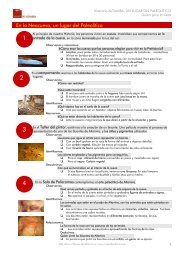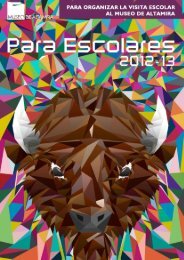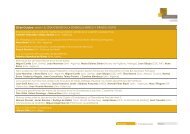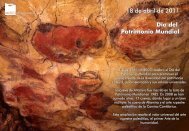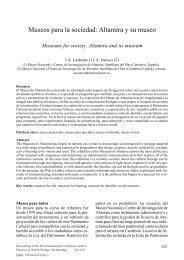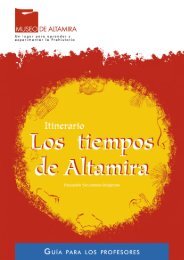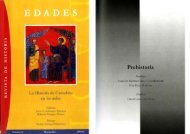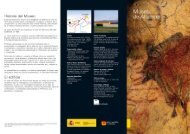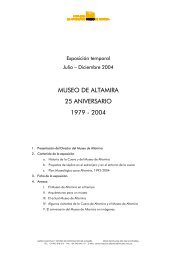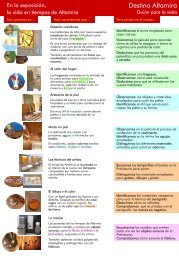Jose A. Lasheras and Carmen de las Heras
Jose A. Lasheras and Carmen de las Heras
Jose A. Lasheras and Carmen de las Heras
- No tags were found...
You also want an ePaper? Increase the reach of your titles
YUMPU automatically turns print PDFs into web optimized ePapers that Google loves.
COALITIONNo. 12, July 2006capabilities of the so-called Cave Men.Together with these arguments, anotherreason why many scientists did not accept theantiquity of the paintings was their excellentstate of conservation <strong>and</strong> their freshness,which ma<strong>de</strong> them believe that they must havebeen painted quite recently.The interest in preserving Altamira had anearly beginning. Its discoverer, M. Sanz <strong>de</strong>Sautuola, who was convinced of the age,importance <strong>and</strong> attraction of the paintings,had a gate fitted in the cave entrance evenbefore publishing his find, in or<strong>de</strong>r to impe<strong>de</strong>any irresponsible acts to the art. Santillana <strong>de</strong>lMar Town Council established from the startthat all visitors should be accompanied by amunicipal gui<strong>de</strong>. Nevertheless, the problemsof conservation had started even before thecave was discovered.Cueva <strong>de</strong> Altamira is formed in limestone karstin a stage of senility. Collapses in it must havebeen occurring for thous<strong>and</strong>s of years, owingto the flat horizontal structure of thelimestone beds. These roof falls have beenrecor<strong>de</strong>d during the human occupations in thePalaeolithic <strong>and</strong> also in mo<strong>de</strong>rn times, in thefirst part of the 20 th Century. In fact, after thecave had remained hid<strong>de</strong>n <strong>and</strong> undisturbed formillennia, its discovery could hardly have beenmore violent; quarrying the rock from abovethe cave with explosives must have openedthe hole which allowed entry to the caveagain. However, the explosions must alsohave fractured the rock strata in the roof ofthe cave, leading to the major collapses thathappened in the entrance hall around 1875<strong>and</strong> in 1925 (during the archaeological digs).The fear that a general collapse might affectthe Polychrome Ceiling meant that between1940 <strong>and</strong> 1965 large concrete supportingwalls were built (imitating natural strata) tostrengthen its stability. These walls created anew “chamber” where the Polychrome Ceilingwas enclosed <strong>and</strong> isolated from the rest of thecave. From this moment on, there was achange in the environmental factors –temperature, humidity, ventilation, etc. – sothat a short time later, the consequences forthe cave <strong>and</strong> the paintings became noticeable.In 1955 some prehistorians <strong>and</strong> art conserverssuggested reducing the number of visitors, but<strong>de</strong>spite the controversy being opened, thetourist use of the cave continued to bepromoted. In this way, the prehistoric cavebecame a great monument for the 20 thCentury, a tourist attraction of the first or<strong>de</strong>r.As well as being an artistic <strong>and</strong> culturall<strong>and</strong>mark, Altamira was important for itseconomic results <strong>and</strong> the image it gave to thepromotion <strong>and</strong> <strong>de</strong>velopment of the region.Therefore, in the 1960s, the ceiling with thepolychrome bisons was enclosed in a space of300 cubic metres, isolated from the rest ofthe cave. This isolation, which was at firstconsi<strong>de</strong>red favourable, reduced even more themargin for the <strong>de</strong>licate physical, chemical <strong>and</strong>microbiological balance nee<strong>de</strong>d to preserve thepaintings.The i<strong>de</strong>a was that visitors would satisfy theircuriosity for seeing the un<strong>de</strong>rground world bybeing gui<strong>de</strong>d through the rest of the cave,where they might also see some engravings orpaintings. For this purpose, the naturalboul<strong>de</strong>ry floor of the cave was transformedinto a wi<strong>de</strong> <strong>and</strong> comfortable path (by diggingit out, filling it in, making steps…). At the endof their visit, they would then be happy with aquick view of the spectacular polychromepaintings. The cave was altered in an attemptto reduce the presence of the public in theHall of the Paintings <strong>and</strong> thus limit theirimpact on such a small volume of air. Thecave suffered from this <strong>de</strong>cision, <strong>and</strong> a banalmulti-colour lighting system was installed,disguised behind rocks.The cave was the tourist pri<strong>de</strong> of the region,<strong>and</strong> one of the most visited ancientmonuments in Spain; more than 100,000people a year after 1964, <strong>and</strong> over 175,000visitors in 1973. The effect of this multitu<strong>de</strong>could have been extremely serious. Thepaintings must have suffered sud<strong>de</strong>n largeoscillations in the humidity <strong>and</strong> temperature,producing physical, chemical <strong>and</strong>microbiological risks that would increase atthe same rate as the visits, <strong>and</strong> which wouldhave caused their <strong>de</strong>struction.Preservation of a fragile heritageAlthough different reports had, since 1955,warned about altering the microclimate insi<strong>de</strong>the cave <strong>and</strong> the need to reduce the numberof visits, it was not until the risk of losing thepaintings became self-evi<strong>de</strong>nt that theauthorities consi<strong>de</strong>red ending the system oftourist exploitation of the cave. Thepreservation of the cave became a politicaldispute between the local <strong>and</strong> regionaladministration on the one h<strong>and</strong> <strong>and</strong> the8
COALITIONNo. 12, July 2006national government on the other, <strong>and</strong>received a great <strong>de</strong>al of public attention. Inthis situation, in 1978 the SpanishGovernment took over the ownership of thecave <strong>and</strong> in 1979 foun<strong>de</strong>d Altamira NationalMuseum <strong>and</strong> Research Centre (AltamiraMuseum) as an efficient instrument forconservation, research <strong>and</strong> management ofthe cave. The cave was closed that sameyear. They <strong>de</strong>ci<strong>de</strong>d against the artificial forcedair conditioning that had proved so disastrousat Lascaux Cave (Montignac, France). Instead,a team led by the Professor of Physics,Eugenio Villar was given the task of studyingthe environmental parameters <strong>and</strong>conservation of the paintings. The naturalmicroclimate of the cave was analysed in theabsence of visitors <strong>and</strong> finally, following amathematical mo<strong>de</strong>l, the number of peoplewho could visit the cave daily withoutaffecting the interior climatic pattern wasfixed. Altamira was opened again in 1982 fora small daily limit of visitors: only 8,500 ayear, in groups of five accompanied by agui<strong>de</strong>, allowing them only ten minutes in thechamber with the Polychrome Ceiling (Villar1984).Figure 1. Some environmental parameters that affect theconservation of the polychrome paintings of Altamira.Figure 2. Repercussions of visitors un<strong>de</strong>r the Polychrome Ceiling(8 groups of five people –accompanied by a gui<strong>de</strong>– for 10minutes).To summarise, the greatest importance wasgiven to controlling the temperature as thekey factor in the un<strong>de</strong>rground system(changes in temperature affect the ventilationby convection, the relative humidity, physical<strong>and</strong> chemical reactions on the rock surface,<strong>and</strong> the microbiological community). Amathematical mo<strong>de</strong>l was created, conjoininginterior <strong>and</strong> exterior climatic parameters <strong>and</strong>the alterations caused by the presence ofpeople so that they would not lead toaccumulative changes insi<strong>de</strong> the Hall of thePaintings. According to this mathematicalmo<strong>de</strong>l, <strong>and</strong> with the proposed regime ofentries <strong>and</strong> visits, the temperature, humidity<strong>and</strong> CO2 level would return to their “natural”values each day, during the hours while thecave was closed, <strong>and</strong> the weak natural annualoscillations would be maintained. Withoutassessing its application, this regime of visitsproposed in 1982 continued in practice until2002, when it was <strong>de</strong>ci<strong>de</strong> to close the caveof Altamira again to make a new diagnosis ofthe conservation conditions.For several years, at the request of AltamiraMuseum, the Council for Scientific Research(CSIC) has been collaborating directly in theanalysis of Altamira’s conservation. A team,led initially by Dr M. Hoyos (<strong>de</strong>ceased in1999) <strong>and</strong> at present by Dr S. Sanchez-Moral(Sanchez-Moral et al. 1999, 2002; <strong>Heras</strong>Martin et al. 2004), is carrying out a series ofstudies to assess the present situation, <strong>and</strong>has noticed some differences from what wasbelieved previously. In 1999 they conclu<strong>de</strong>d aphase of the project in which they assessedthe environmental parameters with the9
COALITIONNo. 12, July 2006existing regime of visits. This is currentlybeing complemented with a study of theclosed cave, which started in 2004.Improvements in the instruments nowavailable (more accurate, reliable <strong>and</strong> easier toh<strong>and</strong>le <strong>and</strong> use), the possibility of monitoringdifferent parameters permanently, <strong>and</strong> somevariations in concepts <strong>and</strong> criteria, hasallowed them to see that the visits regimebeing applied produced a slight increase in thetemperature <strong>and</strong> this did not return to normaleach day. This is in contrast to what theprevious mo<strong>de</strong>l predicted. Equally the CO2level in the air displays an annual cycle withsome differences from what was noted in theearlier study. However, where the presentresearch shows greatest difference is in theimportance given to the humidity (absolute<strong>and</strong> relative), to its changes <strong>and</strong> to the impactma<strong>de</strong> by the entry <strong>and</strong> presence of people in ahumid environment, permanently abovesaturation point. This increases the totalvolume of con<strong>de</strong>nsed water in the Hall ofPaintings significantly. Furthermore, thiscon<strong>de</strong>nsation is produced mainly on theceiling, precisely where the paintings are,accelerating the processes of calcite formation<strong>and</strong> corrosion. Therefore, the physical <strong>and</strong>chemical properties of the water, both in liquid<strong>and</strong> vapour form, are fundamental to controlthe processes of mineral solution <strong>and</strong>precipitation, <strong>and</strong> to <strong>de</strong>fine the dynamicbalances in the cave system (Figures 1 <strong>and</strong> 2).for the preservation of the paintings, becauseof the difficulties for their prevention, theseriousness <strong>and</strong> irreversibility of their possiblenegative effects, <strong>and</strong> the even greaterdifficulty for their correction <strong>and</strong> eradication.So far, only the bacteria that can be cultivatedin the laboratory had been i<strong>de</strong>ntified, but theapplication of molecular techniques atAltamira (based on the sequence of theribosomic RNA gene 16S <strong>and</strong> 23S) hasenabled numerous previously-unknownmicroorganisms to be <strong>de</strong>tected. These inclu<strong>de</strong>both the metabolically active <strong>and</strong> others notactive at the time of sampling (more than70% of those i<strong>de</strong>ntified so far). The intensecolonisation by bacteria produces a stratifiedbiofilm ma<strong>de</strong> up of Bacillus, Acidobacteria,Actinobacteria, Sphingomonas, etc., all ofwhich are sensitive to any alteration in theecosystem. At Altamira, the bacteria appearto neutralise the spread of fungi, but both arethe current main risk for the preservation ofthe prehistoric art in any cave, <strong>and</strong> this doesnot seem to be a matter which has beensufficiently analysed <strong>and</strong> consi<strong>de</strong>red in thecase of the caves with prehistoric art that areopen to the public.Figure 4. The topography of the first section of the cave ofAltamira during the Paleolithic occupations (20.000-13.000 B.P.).Topographic mo<strong>de</strong>l created for the facsimile in the museum:known as Newcave of Altamira.Figure 3. Ground plan <strong>and</strong> profile of the first section of the cave ofAltamira in its current state.Together with this, the colonies of certainmicroorganisms are one of the greatest risksThe present closure of the cave, whichcommenced at the end of 2002, has theoverall aim of analysing the situation withoutthe disturbance of visits. When the study istaken into consi<strong>de</strong>ration together with theassessment ma<strong>de</strong> in 1999, it will produce anew diagnosis on the conservation of10
COALITIONNo. 12, July 2006Altamira. Among the conclusions orconsequences of this diagnosis, in referenceto the management of the cave, there must bea new regime for public access <strong>and</strong> visitscompatible with its preservation. This could bea new mathematical mo<strong>de</strong>l which integratesthe natural variations <strong>and</strong> the disturbancescaused by the visits; a system for constantassessment <strong>and</strong> correction; a <strong>de</strong>finition of thethresholds of risk <strong>and</strong> alarm for eachparameter, <strong>and</strong> the measures to take in eachcase; preventive proposals for the vegetation<strong>and</strong> soil cover above the cave, etc. Logically,also in this case, one of the aims is to makethe public access to this heritage sitecompatible with its preservation.Conservation, research, diffusion … AltamiraMuseum (<strong>Lasheras</strong> <strong>and</strong> <strong>Heras</strong> 1999; <strong>Lasheras</strong> etal. 2002)The studies carried out so far, as well as thenew Museum buildings, opened by their RoyalHighnesses the King <strong>and</strong> Queen of Spain in2001, form part of the same MuseologicalProject, started in 1993 <strong>and</strong> still in force. Thepermanent exhibition in the new museuminclu<strong>de</strong>s a copy of the cave: the Newcave ofAltamira. This has been conceived in anoriginal way, as it reproduces the entrance hall– the habitat area in Palaeolithic times – <strong>and</strong>the area with the Polychrome Ceiling,recreating the appearance it had when thecave was occupied (Figures 3 <strong>and</strong> 4).collapses that occurred soon after that time<strong>and</strong> which sealed the entrance until the 19 thCentury. The replica reconstructs the form ofthe cave, using archaeological <strong>and</strong> geologicalinformation, by interpolating this informationon a highly precise 3D topographical mo<strong>de</strong>l.The Newcave is not an imitation of theoriginal, <strong>and</strong> its viewing cannot be a substitutefor this. Instead, it is a means of informing<strong>and</strong> educating about the original. Two mainreconstructions/restorations ma<strong>de</strong> in thereplica bring us nearer to un<strong>de</strong>rst<strong>and</strong>ing thePalaeolithic cave: the reconstruction of theoriginal large cave entrance (Photo 1), <strong>and</strong> theremoval of the mo<strong>de</strong>rn walls built between theentrance <strong>and</strong> the Hall of the Paintings tosupport the roof (Photo 2). The replica makesit clear that everyday life was carried out inthe daylight zone, <strong>and</strong> not in the darkness ofthe cave. It also shows the absence ofphysical barriers – <strong>and</strong> the importance of thesha<strong>de</strong> – to separate the living space from thearea for the Art, as if to separate the commonarea from that reserved for myths, rites, thetranscen<strong>de</strong>nt <strong>and</strong> the sacred.Photo 2. The Newcave of Altamira in the museum. Image facingthe back of the cave: rendition of the vestibule without themo<strong>de</strong>rn walls built at the entrance, the vestibule <strong>and</strong> the roomwith the polychrome paintings. Toward the left, the stratum of thePolychrome Ceiling is visible. (© Photo: Museum of Altamira/ P.Saura).Photo 1. The Newcave of Altamira in the museum. Image takenfacing the cave entrance: rendition of the vestibule, the originalmouth of the cave <strong>and</strong>, in the forefront of the archaeologicalexcavation. (© Photo: Museum of Altamira/ P. Saura).The cave has suffered great changes since itwas ab<strong>and</strong>oned by its <strong>las</strong>t inhabitants about13,000 years ago. These began with the roofThe reproduction of the paintings is a totallyfaithful copy of the original, even in thetechniques used <strong>and</strong> the pigments employed:ochre <strong>and</strong> charcoal. A few <strong>de</strong>fects that haveoccurred since the art was done thous<strong>and</strong>s ofyears ago have been corrected, improving thevisibility of some of the paintings <strong>and</strong>engravings, especially in the case of somefigures which went unnoticed by mostvisitors. A view of the maximum number offigures is necessary to un<strong>de</strong>rst<strong>and</strong> all thesymbolic content accumulated over such along time in such a small area. This replica hasbeen based on the observations <strong>and</strong> studies11
COALITIONNo. 12, July 2006ma<strong>de</strong> on the original <strong>and</strong> the newphotographic record that has been obtained.This reproduction has been helped by theapplication of mo<strong>de</strong>rn computerisedtechnology, in the topography <strong>and</strong> mo<strong>de</strong>llingas well as in the shaping <strong>and</strong> manufacture ofthe final copy (an accuracy of over 40,000exact points per square metre). This hasenabled the natural architecture of the cave tobe restored to exactly how it was 15,000years ago, according to the archaeological <strong>and</strong>geological research carried out. In this way,both the natural roof falls <strong>and</strong> the mo<strong>de</strong>rnalterations <strong>and</strong> building work suffered by thecave to make it visitable (walls, paths, steps)have been “restored <strong>and</strong> returned” to theiroriginal appearance.Figure 5. 1985. Museum of Altamira <strong>and</strong> the Cave of Altamira.1.Cave of Altamira (inclu<strong>de</strong>d on the World Heritage list). 2.Wi<strong>de</strong>ning of the buffer zone with complete protection <strong>and</strong> control(by the Museum). 3. Building constructed in 1924 <strong>and</strong> renovatedfor the Museum in 1979. 4. Cave of Stalactites (no archaeologicalremains nor prehistoric art). 5. Building <strong>and</strong> footbridge constructedin 1970 for tourism <strong>and</strong> renovated for the Museum in 1979. 6.Parking area. 7. Present-day buffer zone for complete protection(Museum boundaries). 8. Three houses <strong>and</strong> a cattle barn built in1960 – 1980. 9. Water tank, electric transformer <strong>and</strong> electriclines over the Cave of Altamira.Photo 3. The Polychrome Ceiling in the Newcave of Altamira.It must be remembered that the Newcave isnot inten<strong>de</strong>d to contribute to the preservationof the original, <strong>and</strong> that is not its use – wehave already explained what affects thepreservation <strong>and</strong> what needs to be done forthat. It is a response to the great generalinterest in this masterpiece of Prehistoric art.The Newcave should be un<strong>de</strong>rstood simply asa way to know Altamira, like a huge book thatexplains exactly what the cave was like duringthe Palaeolithic, <strong>and</strong> shows it in one amazing“three-dimensional illustration”. It isintellectually accessible <strong>and</strong> attractive toanyone, to all kinds of people with curiosity orinterest. The Newcave is not an instrument ofconservation, but a large book written withmuseological, educational, scientific,technological <strong>and</strong> aesthetic care.Figure 6. 2006. The Cave <strong>and</strong> Museum of Altamira. 1. Cave ofAltamira (inclu<strong>de</strong>d on the World Heritage list). 2. Present daybuffer zone for complete protection (Museum boundaries). 3.Museum property outsi<strong>de</strong> the museum precint. 4. Unused building.5. Building from 1970 renovated for temporary activitites of theMuseum. 6. Cave of Stalactites (no archaeological remains norprehistoric art). 7. Main buiding of the Museum -7a- <strong>and</strong> the newCave of Altamira -7b-. 8. Parking area. 9. Pe<strong>de</strong>strian paths: bufferzone for complete protection <strong>and</strong> control, open to visitors of themuseum as the Park of Altamira.During the <strong>de</strong>velopment of the MuseologicalProject – of which the Newcave is the bestknown part – practically all the conservationmeasures to prevent anthropic risks have beensuccessfully achieved. The l<strong>and</strong> directly abovethe cave has been acquired so that the areabelonging to the museum has increased from50,000 m 2 in 1985 to 160,000 m 2 in 2001.This means there is complete control over thevegetation cover above the cave, preventionof wastes being <strong>de</strong>posited in its impluvialarea, eradication of three houses <strong>and</strong> a farmfrom nearly above the cave, <strong>de</strong>viation oftraffic from the impluvial area (altering the12
COALITIONNo. 12, July 2006Back to in<strong>de</strong>xexisting road layout <strong>and</strong> car park), removal ofa water tank <strong>and</strong> electricity power lines abovethe cave… The museum as an instrument forthe management of the cave, <strong>and</strong> the<strong>de</strong>velopment of the Museological Project forconservation, research <strong>and</strong> diffusion ofAltamira, have ma<strong>de</strong> it possible to affirm thatthe preventive measures for the preservationof Altamira are now much better than theywere before 1993 (Figures 5 <strong>and</strong> 6)Conclusion or Continuation?We believe that we should preserve historicheritage to make use of it; that is, to know it<strong>and</strong> to see it, to enjoy it intellectually <strong>and</strong>culturally now <strong>and</strong> in the future. And a basiccriteria applied to the conservation <strong>and</strong> use ofAltamira is that it should be accessible to thegreatest possible number of people, as long asthe presence of this number of people is not initself a factor of appreciable <strong>de</strong>terioration, <strong>and</strong>as long as this number is <strong>de</strong>termined as aresult of scientific studies on the conservationof the art. These are the studies currentlybeing carried out which, when they conclu<strong>de</strong>,will allow us to establish a new regime forpublic access, suitable for the preservation ofAltamira, inclu<strong>de</strong>d in the list of World Heritagesince 1985.References<strong>Heras</strong>, C. (2002). El <strong>de</strong>scubrimiento <strong>de</strong> la cueva <strong>de</strong> Altamira. In J.A.<strong>Lasheras</strong> (ed.) Re<strong>de</strong>scubrir Altamira: 17-28. Madrid: TurnerLibros.<strong>Heras</strong>, C., <strong>Lasheras</strong>, J.A., Sanchez-Moral, S., Bedoya, J., Cañaveras,J.C., Soler, V. (2004). The preservation of the Cave of Altamira(1880-2002). In Actes du XIVème Congrès UISPP (Belgique2001): 33-42. Oxford: Archaeopress (BAR International Series1313).<strong>Lasheras</strong>, J.A., <strong>Heras</strong>, C. (1999). A new museum <strong>and</strong> a new settingfor the cave of Altamira. International Newsletter on Rock Art 22:25-30.<strong>Lasheras</strong>, J.A., Fatás, P., Albert, M.A. (2002). Un museo para elPaleolítico. In J.A. <strong>Lasheras</strong> (ed.) Re<strong>de</strong>scubrir Altamira: 189-201.Madrid: Turner Libros.Sanchez-Moral, S., Cañaveras, J.C., Soler, V., Saiz-Jimenez, C.,Bedoya, J., Lario, J. (2002). La conservación <strong>de</strong>l monumento. InJ.A. <strong>Lasheras</strong> (ed.) Re<strong>de</strong>scubrir Altamira: 245-258. Madrid:Turner Libros.Sánchez.Moral, S., Cañaveras, J.C., Sanz-Rubio, E., Soler, V., VanGrieken, R., Gysels, K. (1999). Inorganic <strong>de</strong>terioration affectingAltamira Cave. Quantitative approach to wall corrosion (solutionetching) processes induced by visitors. Science of the TotalEnvironment 243: 67-84.Villar, E. (1984). Cueva <strong>de</strong> Altamira: estudios fisico-químicos <strong>de</strong> laSala <strong>de</strong> Polícromos. Influencia <strong>de</strong> la presencia humana y criterios<strong>de</strong> conservación. Madrid: Ministerio <strong>de</strong> Cultura (Monografías <strong>de</strong>lMuseo <strong>de</strong> Altamira 11).ROCK ART RESEARCH IN NORTHERNMEXICO, PAST AND PRESENTMª <strong>de</strong> la Luz Gutiérrez MartínezCentro INAH - Baja California Sur. La Paz, BCS- MexicoIntroductionThe archaeological research in northernMexico has been a complex <strong>and</strong> slow process.One of the major reasons for this situation isthe consistent <strong>and</strong> transcen<strong>de</strong>ntal presence ofthe Mesoamerican cultures <strong>de</strong>veloped in thiscountry. Mesoamerica constituted a greatpart of the Mexican territory, fromapproximately the 28º parallel to the currentterritory of Central America. With thisinterminable source of study, Mexican <strong>and</strong>international archaeologists lead their interestalmost exclusively to the Mesoamericancultures, <strong>de</strong>veloping important research onthis marvelous <strong>and</strong> un<strong>de</strong>niable inheritance.Consequently, the advance reached onMesoamerica’s knowledge has beensubstantial, mainly during the second half ofthe Twentieth century.While this was happening, beyond thenorthern limits of what once was theexten<strong>de</strong>d <strong>and</strong> belligerent Mexica Empire, theregion called the “Gran Chichimeca” kept itssecrets un<strong>de</strong>r the protection of its vast, rustic<strong>and</strong> remote territory. In pre-Hispanic times,this distant <strong>and</strong> unknown region was muchfeared because it was <strong>de</strong>emed as ageographic space associated with <strong>de</strong>ath <strong>and</strong>with all types of lacks <strong>and</strong> calamities:“They called that region the Chichimecatlalli -orl<strong>and</strong> of the Chichimecas- <strong>and</strong> also the TeotlapanTlacochcalco Mictampla -or ‘spacious fields thatare towards the north- place of the <strong>de</strong>ath’“(Braniff et al. 2001)Although those distant <strong>and</strong> mysterious regionsdid not have the geographical <strong>and</strong> ecologicaladvantages that prevailed in Mesoamerica,which were so important for the <strong>de</strong>velopmentof notable civilizations; it did not mean thatsplendor <strong>and</strong> cultural complexity were notreached in such remote region, as will be seenlater in this article (Figure 1).13



